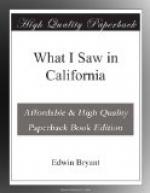The valley contiguous to the mission is extensive, well watered by a large arroyo, and highly fertile. The gardens and other lands for tillage are inclosed by willow hedges. Elevated hills, or mountains, bound this valley on the east and west. Large herds of cattle were scattered over the valley, greedily cropping the fresh green herbage, which now carpets mountain and plain.
Colonel Fremont marched from San Juan this morning, and encamped, as we learned on our arrival, ten miles south. Proceeding up the arroyo on the 29th, we reached the camp of Colonel F. about noon. I immediately reported, and delivered over to him the men and horses under my charge. The men were afterwards organized into a separate corps, of which Mr. R.T. Jacob, my travelling companion, was appointed the captain by Colonel Fremont.
CHAPTER IX.
California battalion
Their appearance and costume
List of the officers
Commence our march to Los Angeles
Appearance of the country in the vicinity
of San Juan
Slaughter of beeves
Astonishing consumption of beef by the
men
Beautiful morning
Ice
Salinas river and valley
Californian prisoners
Horses giving out from fatigue
Mission of San Miguel
Sheep
Mutton
March on foot
More prisoners taken
Death of Mr. Stanley
An execution
Dark night
Capture of the mission of San Luis Obispo
Orderly conduct and good deportment of
the California battalion.
November 30.—The battalion of mounted riflemen, under the command of Lieutenant-Colonel Fremont, numbers, rank and file, including Indians, and servants, 428. With the exception of the exploring party, which left the United States with Colonel F., they are composed of volunteers from the American settlers, and the emigrants who have arrived in the country within a few weeks. The latter have generally furnished their own ammunition and other equipments for the expedition. Most of these are practised riflemen, men of undoubted courage, and capable of bearing any fatigue and privations endurable by veteran troops. The Indians are composed of a party of Walla-Wallas from Oregon, and a party of native Californians. Attached to the battalion are two pieces of artillery, under the command of Lieutenant McLane, of the navy. In the appearance of our small army there is presented but little of “the pomp and circumstance of glorious war.” There are no plumes nodding over brazen helmets, nor coats of broadcloth spangled with lace and buttons. A broad-brimmed low-crowned hat, a shirt of blue flannel, or buckskin, with pantaloons and mocassins of the same, all generally much the worse for wear, and smeared with mud and dust, make up the costume of the party, officers as well as men. A leathern girdle surrounds the waist, from which are suspended a bowie and a hunter’s knife, and




